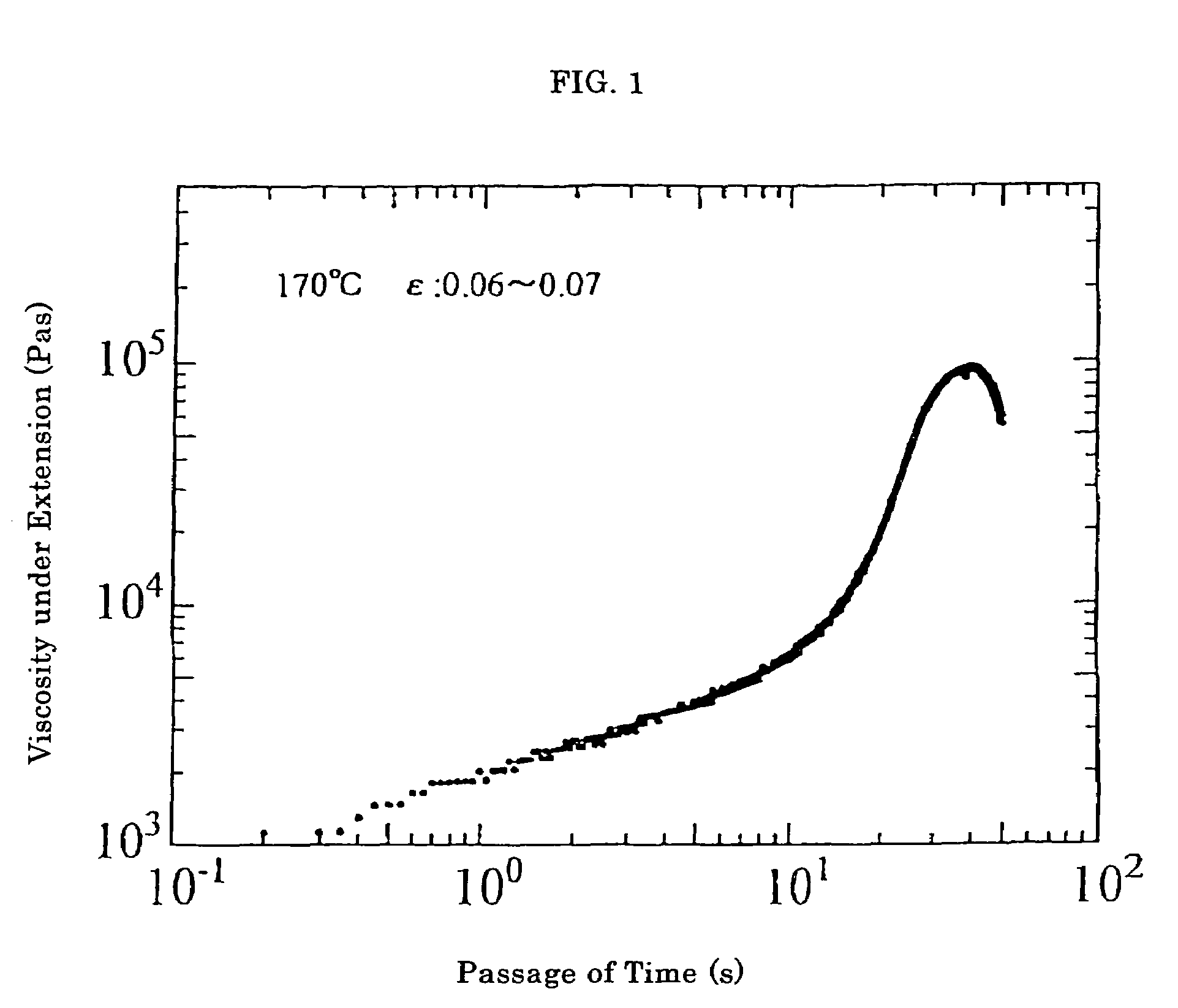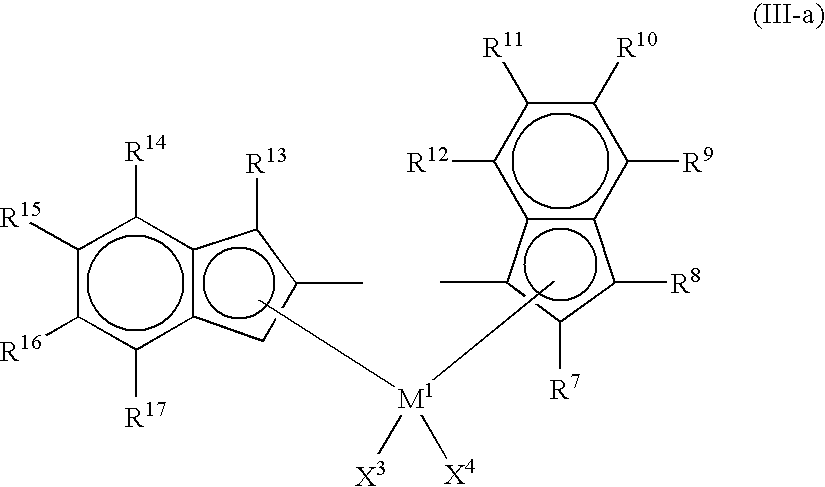Process for producing polyolefin resin composition and polypropylene composition
a technology of polypropylene and resin composition, which is applied in the field of polyolefin-based resin composition and polypropylene composition production, can solve the problems of insufficient improvement of molding ability, novel physical properties, and no other effective control methods, and achieve excellent workability, improved workability in molding polyolefins, and control physical properties in a wide range of effects
- Summary
- Abstract
- Description
- Claims
- Application Information
AI Technical Summary
Benefits of technology
Problems solved by technology
Method used
Image
Examples
example 1
Preparation of a Polypropylene Composition
(1) Preparation of an Aluminum Oxy Compound
[0444]Using 1,000 milliliters of a toluene solution of methylaluminoxane (1.47 moles / liter; produced by Albemarle Co., Ltd.; the content of trimethylaluminum: 14.5% by weight), the solvent was removed under a reduced pressure (about 20 mmHg) at 60° C. After the resultant product was kept in this condition for 4 hours, the temperature was lowered to the room temperature and a dried-up methylaluminoxane was obtained.
[0445]To the dried-up methylaluminoxane, dehydrated toluene was added to dissolve methylaluminoxane and the volume of the solution was adjusted at the volume of the solution before the solvent was removed. The amount of trimethylaluminum in the methylaluminoxane was determined in accordance with 1H-NMR and found to be 3.6% by weight. The amount of the entire aluminum was measured in accordance with the fluorescence X-ray method (the ICP method) and found to be 1.32 moles / liter. The above m...
examples 2 to 6
Various Values of Parameters in the Multi-stage Polymerization
[0453]Using the catalyst shown in Example 1 (3), polypropylene compositions were prepared under various conditions shown in Table 4. The results of the measurements of the obtained polypropylene compositions are shown in Table 5.
[0454]
TABLE 4Condition of the first polymerization stagepressurehydro-oftem-SiO2 / MAOZrgenpropyleneperaturetime(mmol-Al)(μmol)(ml)(MPa)(° C.)(min)Example 22.02300.656090Example 32.02300.656090Example 42.02300.656090Example 52.05*0.020.656090Example 62.02300.656090*The unit: MPaCondition of the second polymerization stagepressure of1,9-decadienepropylenetemperaturetime(mmol)*(MPa)(° C.)(min)Example 20.10.7 × 10−60.654060Example 30.21.2 × 10−60.654060Example 40.32.0 × 10−60.654060Example 50.53.2 × 10−60.706060Example 60.21.6 × 10−60.653060*Amount by mole per 1 g of the polymer obtained in the first polymerization stage.
[0455]
TABLE 5FractionAmountininFractionAmountsecondsecondMIBulkMeltinsolubleobtain...
examples 7 to 16
Various Polyenes
[0456]Polypropylene compositions were prepared in accordance with the same procedures as those conducted in Example 1 (4) except that polyenes shown in Table 6 were used in place of the polyene used in Example 1 (4). The results of the measurements of the obtained polypropylene compositions are shown in Table 6.
[0457]
TABLE 6FractionAmountAmountininpolyeneob-secondsecondEx-amounttainedstage#stage##amplecompound(mmol)*(g)(%)(g) 7divinyl-0.21.6 × 10−614010.514.7benzene 81,5-hexa-0.22.0 × 10−61128.59.52diene 91,6-hepta-0.21.7 × 10−61339.512.6diene101,7-octa-0.21.7 × 10−61255.06.25diene11p-3-butenyl-0.21.7 × 10−613512.516.9styrene12p-5-pro-0.21.7 × 10−613011.515.0penylstyrene13norborna-0.21.6 × 10−614112.517.6diene145-(3-0.21.8 × 10−61227.59.15butenyl)bi-cyclo-[2.2.1]hept-2-ene155-vinyl-2.01.9 × 10−511810.512.4nobornene16dicyclo-2.01.4 × 10−51578.513.3pentadiene#The fraction of the polymer obtained in the second polymerization stage.##The amount of the polymer obtained in...
PUM
| Property | Measurement | Unit |
|---|---|---|
| pressure | aaaaa | aaaaa |
| temperature | aaaaa | aaaaa |
| temperature | aaaaa | aaaaa |
Abstract
Description
Claims
Application Information
 Login to View More
Login to View More - R&D
- Intellectual Property
- Life Sciences
- Materials
- Tech Scout
- Unparalleled Data Quality
- Higher Quality Content
- 60% Fewer Hallucinations
Browse by: Latest US Patents, China's latest patents, Technical Efficacy Thesaurus, Application Domain, Technology Topic, Popular Technical Reports.
© 2025 PatSnap. All rights reserved.Legal|Privacy policy|Modern Slavery Act Transparency Statement|Sitemap|About US| Contact US: help@patsnap.com



